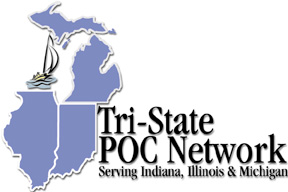
|
MINUTES FROM OUR DECEMBER 4, 2002
MEETING |
||||||||||||||||||||||||||||||
|
Click on one of the links
below for specific program reviews of this meeting:
POC Using the ESA Lead Care Analyzer Quality Improvement/Quality Assurance in POCT |
The third meeting in 2002 of the Tri-State POC Network serving Illinois, Indiana and Michigan took place at the Radisson Hotel in Merrillville, Indiana on Wednesday, December 4, 2002 from 8:00 AM to 3:00 PM. The meeting was attended by 60 registered healthcare professionals as well as representatives from the program sponsors and vendors:
The meeting commenced with the introduction of the core group and opening remarks by Darlene Sobucki, founder of the Tri-State POC Network. Members of the core group include:
The first presenter for the day was Barb Jung, sales rep for both the Hemocue and the ESA Lead Care Analyzer. Barb’s presentation, “POC Using the ESA Lead Care Analyzer”, included why the test is performed, symptoms of the disease, testing schedule, type of specimen used, and available proficiency testing (free through Wisconsin State Labs). She also sated that less than 20% of Medicaid children are being screened even though testing is required for children 1 – 16 years old. Lou
Ann Wyer (sponsored by Abbott Diagnostics) discussed the importance of
“Quality Improvement/Quality Assurance in POCT”.
Lou Ann manages 3000 operators in 5 facilities of the Sentara
Healthcare System and was named POCC of the Year by AACC. She recommends
following the NCCLS Model for Quality Health Plan and to provide an annual
survey to the Nursing staff about how the POCT program is doing. Quality
indicators should include High risk/high volume tests and customer service
issues. Examples of indicators: patient ID, number of re-runs for either
patient testing or QC testing, and dating of reagents.
She also recommends monitoring MD notification of panic results by
performing an audit in Medical Records.
As for treatment issues, if treatment is not given within 8 hours
based on POCT then the test should be performed in the lab only. Once a process improvement has been identified, steps need to be taken to demonstrate an action to improve the process. In her facility, self-learning packets are given in which the employee(s) researches the error, identifies how it occurred, the impact on the patient, and steps to take so the error won’t occur again. A test is included at the end of the exercise. Lou Ann also stresses the importance of rewarding success with each demonstrated improvement. Establishing timeliness is a must. From 10:30 to 12:30, attendees visited the twenty-three vendor tables at the Network’s first Vendor Fair. This was an opportunity to see the various POC testing devices available, try a little hands on, meet the reps, and gather lots of information to take back to the various facilities. It also gave the vendors the opportunity to learn what is important to the end user. Kudos to Darlene Sobucki for organizing the event and many thanks to the vendors who participated. Following
lunch, we listened to Adrienne Malta from CAP present
“Preparing Your POCT for a CAP Accreditation Inspection”.
Adrienne presented at the first Network Meeting in November 2001,
so we were thrilled to have her back for our first anniversary. Adrienne
outlined the steps on how to prepare for your inspection, starting with
the application all the way to the actual inspection.
As always, proficiency testing and quality control head the list of
what an inspector will review, followed by reagents, manuals/procedures
and personnel competency records. She recommends mock inspections to
determine if any deficiencies exist so corrections can be implemented. Changes
to the November 22, 2002 POCT Checklist include: reorganization of the
checklists into 5 sections as well as AMR/CRR changes (Analytic
Measurement Range and Clinical Measurement Range). Considerable time was
spent with the discussion about AMR/CRR/Calibration
Verification. New to
the checklist is the Physician Performed Testing section which is not the
same as the CLIA-88 term ‘provider performed microscopy”.
PPT is defined by CAP as testing that is personally performed by a
physician in conjunction with the physical examination or treatment of a
patient such as: KOH preparations, amniotic fluid pH, gastric biopsy.
Policies that outline the nature and scope of laboratory testing
personally performed by the physician need to be written as well as
procedure manuals, establishing a QI program, training, credentialing or
competency program and result reporting system. Alternative Test Systems encompasses newer technologies and testing performed by non-traditional analytic methods and specimens, including unusual specimen type (breath testing for H. pylori), in vivo monitoring devices based on traditional specimen types (Bleeding time, blood gases) and no specimen physically removed from a patient (transcutaneous bilirubin measurements). And yes, manuals, QC procedures, etc are required. The next meeting will be April 2, 2003 at the Radisson Hotel, Merrillville, IN. Thank you
to Wendy Denk, MT (ASCP) for
submitting this information. |
|||||||||||||||||||||||||||||
| Back to top | ||||||||||||||||||||||||||||||
Return to PointofCare.net Home Page
Questions or corrections: Webmaster